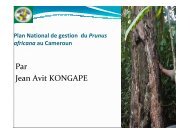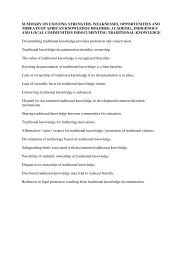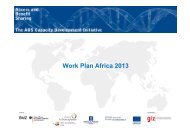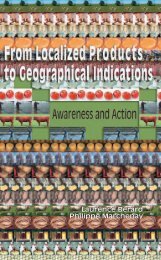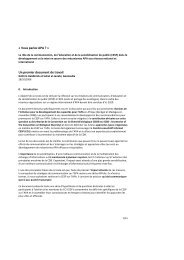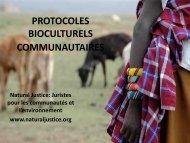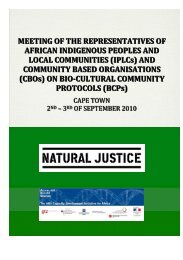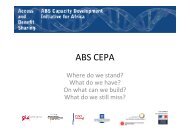The History of Farmers' Rights - Fridtjof Nansens Institutt
The History of Farmers' Rights - Fridtjof Nansens Institutt
The History of Farmers' Rights - Fridtjof Nansens Institutt
Create successful ePaper yourself
Turn your PDF publications into a flip-book with our unique Google optimized e-Paper software.
10 Regine Andersen<br />
<strong>The</strong> Council noted with satisfaction the Commission’s decision to<br />
initiate negotiations through its Working Group to achieve an<br />
agreed interpretation <strong>of</strong> the controversial parts <strong>of</strong> the international<br />
Undertaking on Plant Genetic Resources, and to include in this<br />
interpretation clarification and recognition <strong>of</strong> plant breeders’ rights<br />
and farmers’ rights.<br />
However, in the ensuing Twenty-fourth Session <strong>of</strong> the Conference in<br />
Rome in November 1987, there was no reported mention <strong>of</strong> farmers’<br />
rights (C 1987/REP: Report <strong>of</strong> the Conference <strong>of</strong> FAO Twenty-fourth<br />
Session, Rome, 7–27 November 1987).<br />
***<br />
As we can see from these reports from the four relevant meetings in 1986<br />
and 1987, opinion differed as to the concept <strong>of</strong> farmers’ rights and<br />
whether and how to give it recognition. However, various considerations<br />
and practical solutions were suggested already at this point (particularly<br />
in 1987), and these were more or less reflected in later discussions, in the<br />
literature and in the final recognition <strong>of</strong> farmers’ rights in the International<br />
Treaty. <strong>The</strong> negotiations in 1987 can be said to form the foundation<br />
for all further negotiations on farmers’ rights, and provided substantial<br />
input to the framing <strong>of</strong> our current understanding <strong>of</strong> the concept.<br />
2.2 A note on the Keystone Dialogues<br />
Keystone Center (1991): Oslo Plenary Session. Final Consensus<br />
Report: Global Initiative for the Security and Sustainable Use <strong>of</strong> Plant<br />
Genetic Resources. Third Plenary Session, 31 May–4 June 1991,<br />
Oslo, Norway (Keystone, Colorado: Keystone Center).<br />
In the controversies on control over genetic resources in the 1980s, there<br />
were deep conflict lines between the parties. That is why William Brown,<br />
then chair <strong>of</strong> the US National Board for Plant Genetic Resources, initiated<br />
a contact with the Keystone Center in Colorado, with the request <strong>of</strong><br />
holding a dialogue on plant genetic resources among international stakeholders.<br />
11 <strong>The</strong> Keystone Approach was to invite stakeholders as individuals,<br />
to reduce conflict level and seek dialogue, to keep the discussions<br />
<strong>of</strong>f the record, and to produce a report on the basis <strong>of</strong> consensus only.<br />
<strong>The</strong> Keystone Dialogues took place in 1988, 1990 and 1991, in Keystone,<br />
in Madras (now Chennai) and in Oslo respectively, and were chaired by<br />
Pr<strong>of</strong>. M.S. Swaminathan, who also led an Interim Steering Committee<br />
that gave direction to the dialogues. Facilitators were the staff <strong>of</strong> the<br />
Keystone Center.<br />
<strong>The</strong> Center gathered altogether 92 stakeholders from 30 countries at its<br />
three sessions and was important in framing the international discussions<br />
on such issues as farmers’ rights, common heritage <strong>of</strong> mankind, international<br />
funding and to some extent intellectual property rights. <strong>The</strong> 1990<br />
11 Cary Fowler (1994): Unnatural Selection. Technology, Politics and Plant<br />
Evolution (Yverdon, Switzerland: Gordon and Breach), p. 197.





